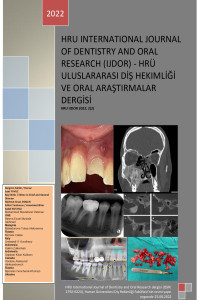Treatment of Eagle’s Syndrome By Intended Fracture of The Styloid Process: Report of Two Cases
Treatment of Eagle’s Syndrome By Intended Fracture of The Styloid Process: Report of Two Cases
Eagle’s syndrome, fracture, styloid,
___
- 1. Boucher Y, Mularski A, Felizardo R, Tankere F, Dieb M. Chronic oropharyngeal pain and medical nomadism in an Eagle's syndrome patient: a case report. J Med Case Rep. 2022;16(1):201. Published 2022 May 12. doi:10.1186/s13256-022-03372-0 ).
- 2. Fini G, Gasparini G, Filippini F, Becelli R, Marcotullio D. The long styloid process syndrome or Eagle’s syndrome. J Craniomaxillofac Surg. 2000; 28:123-127.
- 3. Sigdel B, Karn M, Sah K. Bilateral elongated styloid processes: Eagle syndrome. Lancet. 2021 Apr 10;397(10282):1387.
- 4. Yetiser S, Gerek M, Ozkaptan Y. Elongated styloid process: diagnostic problems related to symptomatology. Cranio.1997;15:3:236–241.
- 5. Mayrink G, Figueiredo EP, Sato FR, Moreira RW. Cervicofacial pain associated with Eagle’s syndrome misdiagnosed as trigeminal neuralgia. Oral Maxillofac Surg. 2012;16:207-210.
- 6. Ersan N, İlgüy M, İlgüy D. Eagle sendromu: Olgu bildirimi. Acta Odontologica Turcica. 2016;33:1:30-34.
- 7. Huang K, Sanjuan-Sanjuan A, Cannavo M, Cass T, Ramirez CA. Does Transcervical Styloidectomy for Eagle Syndrome Improve Quality of Life? J Oral Maxillofac Surg. 2022 Dec;80(12):1989-1995.
- 8. Badhey A, Jategaonkar A, Kovacs AJA, Kadakia S, De Deyn PP, Ducic Y, et al. Eagle syndrome: A comprehensive review. Clin Neurol Neurosurg. 2017;159:34-38.
- 9. Al Weteid A.S., Miloro M.: Transoral endoscopic-assisted styloidectomy: How should Eagle syndrome be managed surgically?. Int J Oral Maxillofac Surg 2015; 44: pp. 1181-1187.
- 10. Fusco DJ, Asteraki S, Spetzler RF. Eagle's syndrome: embryology, anatomy, and clinical management. Acta Neurochir (Wien). 2012 Jul;154(7):1119-26.
- 11. Savranlar A, Uzun L, Uğur MB, Ozer T. Three-dimensional CT of Eagle’s syndrome. Diagn Interv Radiol. 2005;11:4:206-209.
- 12. Piagkou M, Anagnostopoulou S, Kouladouros K, Piagkos G. Eagle's syndrome: a review of the literature. Clin Anat. 2009;22:5:545–558.
- 13. Green BN, Browske LKM. Elongated styloid processes and calcified stylohyoid ligaments in a patient with neck pain: implications for manual therapy practice. J. Chiropr. Med. 2014;13:2:128–133.
- 14. Chase DC, Zarmen A, Bigelow WC, McCoy JM. Eagle's syndrome: a comparison of intraoral versus extraoral surgical approaches. Oral Surg Oral Med Oral Pathol. 1986;62:6:625–629.
- 15. Murthy PS, Hazarika P, Mathai M, Kumar A, Kamath MP. Elongated styloid process: an overview. Int J Oral Maxillofac Surg. 1990;19:4:230–231.
- 16. Sham E, Reddy TJ, Menon PS, et al. Anterior Tonsillar Fossa Approach to Elongated Styloid Process. Ann Maxillofac Surg. 2020;10(1):203-209.
- 17. Boedts D. Styloid process syndrome or stylohyoid syndrome? Acta Otorhinolaryngol Belg. 1978;32:273–8.
- 18. Zhang YL, Liao DM, Wei YG, Bai GR. Styloid process syndrome: Length and palpation of the styloid process. Chin Med J (Engl) 1987;100:56–7.
- 19. Chase DC, Zarmen A, Bigelow WC, McCoy JM. Eagle's syndrome: A comparison of intraoral versus extraoral surgical approaches. Oral Surg Oral Med Oral Pathol. 1986;62:625–9.
- 20. Beder E, Ozgursoy OB, Karatayli Ozgursoy S. Current diagnosis and transoral surgical treatment of Eagle's syndrome. J Oral Maxillofac Surg. 2005;63:1742–5.
- 21. Chrcanovic BR, Custódio AL, de Oliveira DR. An intraoral surgical approach to the styloid process in Eagle's syndrome. Oral Maxillofac Surg. 2009;13:145
- 22. Martins WD, Ribas Mde O, Bisinelli J, França BH, Martins G. Eagle's syndrome: treatment by intraoral bilateral resection of the ossified stylohyoid ligament. A review and report of two cases. Cranio. 2013;31:3:226-31.
- 23. Sharma N, Ram R, Kamal R. Unusually elongated styloid process: A report of two cases with literature review. Ann Maxillofac Surg. 2016;6:2:297-299.
- 24. Kaur A, Singh A, Singal R, Gupta S. Is this way; self inflicted fracture of styloid process cures stylalgia. J Med Life. 2013;6:2:202.
- Başlangıç: 2021
- Yayıncı: Harran Üniversitesi
Evaluation of CFR-PEEK Miniplates with Finite Element Analysis in Mandibular Angle Fracture
Mehmet Zahit BAŞ, Enes BEKMAN, Musa ERDEM
Meryem BAYAM KARA, Elif Nur YOLCU, Sadullah KAYA
Bibliometric Analysis of Turkish Endodontic Journal
Treatment of Eagle’s Syndrome By Intended Fracture of The Styloid Process: Report of Two Cases
Meriç DEVELİ, Öznur ÖZALP, Alper SİNDEL
ERGENLİK ÇAĞINDAKİ ÖĞRENCİLERİN BESLENME İLE DİŞ SAĞLIĞI ARASINDAKİ İLİŞKİNİN İNCELENMESİ
Mehmet Sinan DOĞAN, Zelal ALMAK, Maksut CENGİZ, Sedef KOTANLI
Büşra KARAAĞAÇ ESKİBAĞLAR, Buket AYNA
Management Of Oral Ranula With Modified Micro-Marsupialization
Zülfikar KARABIYIK, Mahmut Sami YOLAL, Mohammad Nabi BASİRY
LUMBAR DİSK HERNİSİ OPERASYONLARININ ENDOTRAKEAL KAF BASINCINA VE TRAKEAL MORBİDİTEYE ETKİSİ
Yusuf İPEK, Zeynep BAYSAL, Enes ÇELİK, Hakan AKELMA
